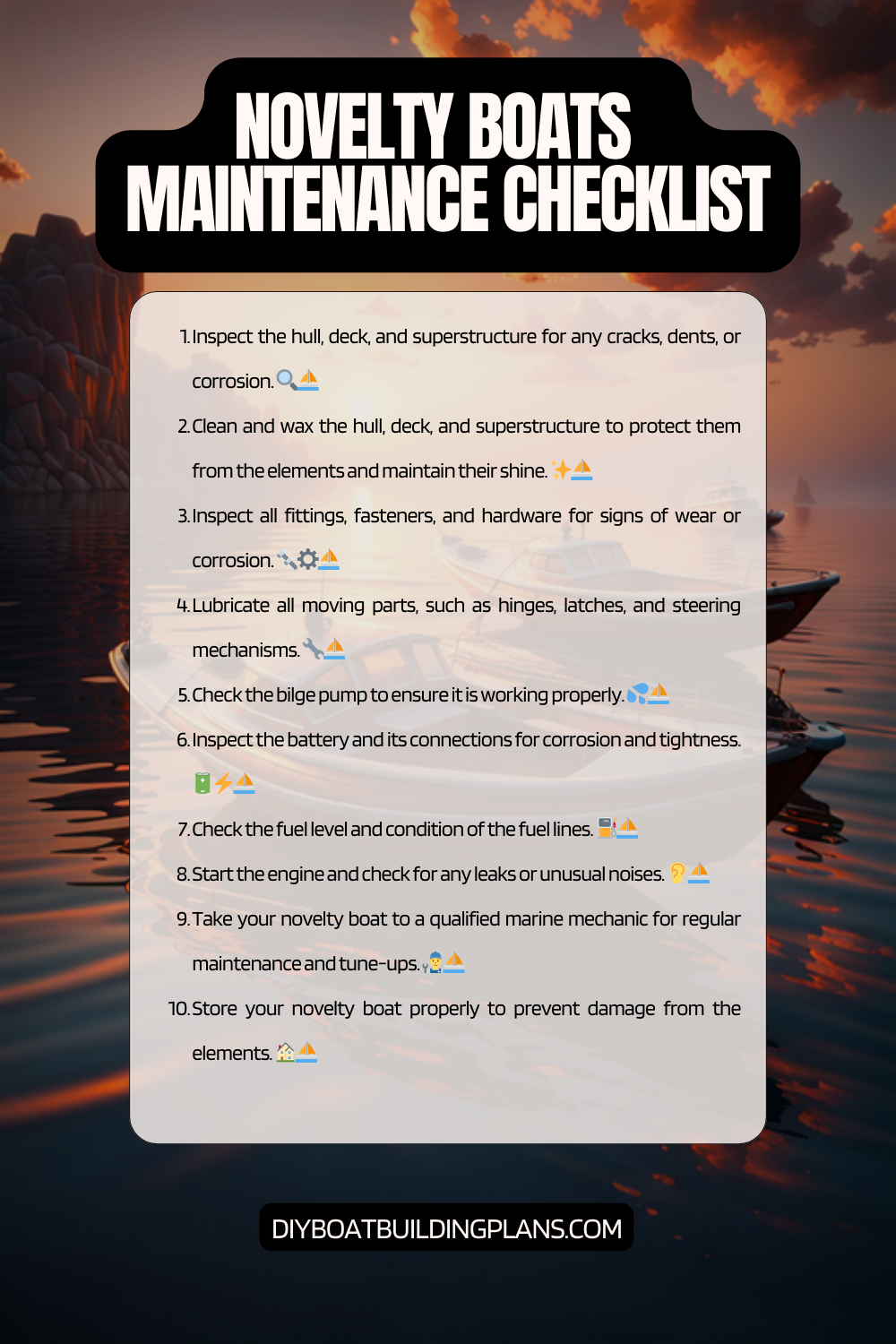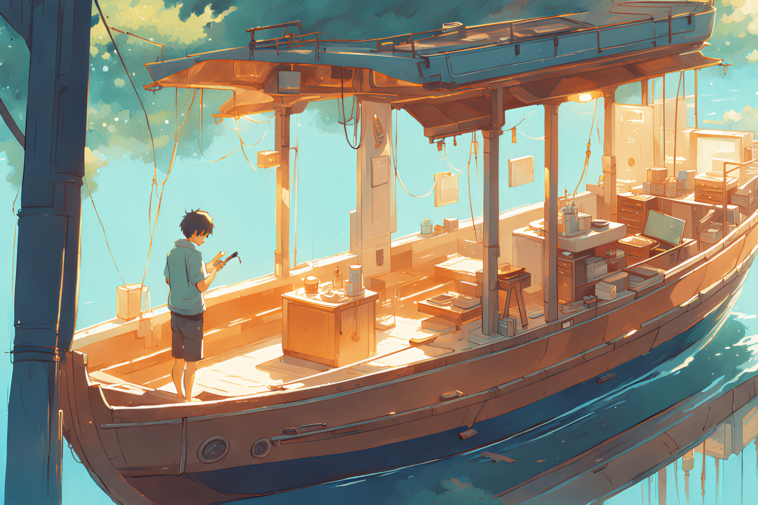Overview of Novelty Boat Maintenance Tips
Novelty boats are a unique and exciting category of watercraft that are designed to stand out from the crowd. These boats are often characterized by their unconventional shapes, vibrant colors, and eye-catching designs. They are meant to be fun, attention-grabbing, and a source of entertainment for both the owners and onlookers. Novelty boats come in various forms, such as giant rubber ducks, floating castles, or even oversized animals. The possibilities are endless when it comes to the creativity and imagination that can be incorporated into these vessels.
Some popular examples of novelty boats include the Hot Tub Boat, which combines the luxury of a hot tub with the thrill of being on the water; the BBQ Donut Boat, where you can enjoy a delicious meal while cruising along; and the Tiki Hut Boat, which allows you to relax in a tropical-themed floating paradise. These boats not only provide a unique experience but also serve as conversation starters and attractions at events or parties. Novelty boats have gained popularity in recent years due to their ability to bring joy and excitement to boating enthusiasts.
Key Takeaways
- Regular maintenance is crucial for novelty boats to ensure their longevity and performance.
- Cleaning and polishing the exterior, checking and replacing the battery, inspecting and repairing the hull, lubricating the engine and moving parts, testing and replacing the spark plugs, and maintaining the fuel system are all important maintenance tasks.
- Winterizing the boat and storing it properly are also essential to prevent damage during the off-season.
- Neglecting maintenance can lead to costly repairs and even safety hazards.
- By following these maintenance tips, novelty boat owners can enjoy their vessels for years to come.

Importance of Regular Maintenance
Regular maintenance is crucial for any type of boat, including novelty boats. By properly maintaining your novelty boat, you can ensure its longevity, performance, and safety. Neglecting maintenance can lead to a range of issues that can be costly to repair and may even put your safety at risk.
One of the key benefits of regular maintenance is that it helps prevent major breakdowns or malfunctions. By regularly inspecting and servicing your boat, you can identify potential problems early on and address them before they escalate into more significant issues. This proactive approach can save you time, money, and frustration in the long run.
On the other hand, neglecting maintenance can have severe consequences. For example, failing to check and replace the battery regularly can result in a dead battery when you least expect it, leaving you stranded on the water. Ignoring hull damage can lead to water leaks and structural issues that can compromise the safety and integrity of the boat. By prioritizing regular maintenance, you can avoid these potential pitfalls and enjoy a worry-free boating experience.
Cleaning and Polishing the Exterior
Keeping the exterior of your novelty boat clean and polished not only enhances its appearance but also protects it from the elements. Here are some essential tools and materials you will need for this task:
– Soft bristle brush or sponge
– Boat soap or mild detergent
– Bucket of water
– Microfiber towels or chamois
– Boat wax or polish
To clean and polish the exterior of your novelty boat, follow these steps:
1. Rinse the boat with fresh water to remove any loose dirt or debris.
2. Fill a bucket with water and add boat soap or mild detergent according to the manufacturer’s instructions.
3. Dip the soft bristle brush or sponge into the soapy water and gently scrub the entire exterior surface of the boat, paying extra attention to areas with stubborn stains or grime.
4. Rinse off the soap residue with fresh water.
5. Dry the boat thoroughly using microfiber towels or a chamois to prevent water spots.
6. Apply boat wax or polish using a clean cloth, following the product instructions.
7. Buff the waxed or polished surface with a separate clean cloth to achieve a shiny finish.
Regularly cleaning and polishing the exterior of your novelty boat will not only keep it looking its best but also protect it from UV rays, saltwater corrosion, and other environmental factors that can cause damage over time.
Checking and Replacing the Battery
| Task | Frequency | Time Required | Cost |
| Checking Battery Voltage | Every 3 months | 5 minutes | 0 |
| Replacing Battery | Every 3-5 years | 30 minutes | 50-200 |
| Testing Battery Capacity | Every 6 months | 10 minutes | 0 |
The battery is an essential component of any boat, including novelty boats. It provides power for starting the engine, operating electrical systems, and running various onboard equipment. Regularly checking and replacing the battery is crucial to ensure reliable performance. Here’s why the battery is important and how to check and replace it:
The battery plays a vital role in starting the engine. A weak or dead battery can prevent your novelty boat from starting, leaving you stranded on the water. It is essential to check the battery’s voltage regularly to ensure it is in good condition. Signs of a weak battery include slow cranking or difficulty starting the engine, dimming lights, and a clicking sound when turning the key.
To check and replace the battery:
1. Start by turning off all electrical systems and removing the key from the ignition.
2. Locate the battery compartment, usually found in the engine compartment or under a seat.
3. Inspect the battery for any signs of corrosion, such as white or greenish deposits on the terminals. If present, clean the terminals using a wire brush and a mixture of baking soda and water.
4. Use a voltmeter or multimeter to measure the battery’s voltage. A fully charged battery should read around 12.6 volts.
5. If the voltage is significantly lower than 12 volts, it may indicate a weak or discharged battery that needs to be replaced.
6. To replace the battery, disconnect the negative (-) cable first, followed by the positive (+) cable.
7. Remove any brackets or fasteners holding the battery in place and carefully lift it out of the compartment.
8. Install the new battery by reversing the removal process, ensuring proper connection of the positive (+) and negative (-) cables.
9. Securely fasten the new battery in place and double-check all connections.
Regularly checking and replacing your novelty boat’s battery will help ensure reliable performance and prevent unexpected breakdowns on the water.
Inspecting and Repairing the Hull
The hull is one of the most critical components of any boat, including novelty boats. It provides buoyancy, stability, and structural integrity. Regularly inspecting and repairing the hull is essential to maintain the safety and performance of your novelty boat. Here’s why the hull is important and how to inspect and repair it:
The hull is responsible for keeping your boat afloat and providing stability on the water. Any damage to the hull can compromise its structural integrity, leading to water leaks, reduced buoyancy, and potential safety hazards. Signs of hull damage may include cracks, dents, scratches, or soft spots.
To inspect and repair the hull:
1. Start by thoroughly cleaning the hull to remove any dirt or debris that may hide potential damage.
2. Inspect the entire hull surface, both above and below the waterline, for any signs of damage.
3. Use a flashlight to check for cracks or fractures that may not be visible to the naked eye.
4. Pay close attention to areas where the hull meets other components, such as through-hull fittings or transom joints.
5. If you notice any cracks or damage, mark them with tape or a waterproof marker for easier identification during repairs.
6. Depending on the severity of the damage, you may need to consult a professional boat repair technician for proper repairs.
7. For minor scratches or gouges, you can use a marine-grade epoxy or gel coat repair kit to fill and smooth out the damaged area.
8. Follow the manufacturer’s instructions for mixing and applying the repair material.
9. Once the repair material has cured, sand it down using fine-grit sandpaper until it is smooth and level with the surrounding hull surface.
10. Finish by applying a marine-grade wax or polish to protect and restore the repaired area.
Regularly inspecting and repairing your novelty boat’s hull will help ensure its structural integrity, buoyancy, and overall safety on the water.
Lubricating the Engine and Moving Parts
Proper lubrication is essential for maintaining the performance and longevity of your novelty boat’s engine and moving parts. Lubrication reduces friction, heat, and wear, ensuring smooth operation and preventing premature component failure. Here’s why lubrication is important and how to lubricate the engine and moving parts:
Lubrication plays a crucial role in reducing friction between metal surfaces that come into contact with each other during operation. Without proper lubrication, these surfaces can wear down quickly, leading to increased heat generation, decreased efficiency, and potential damage to the engine or other moving parts.
To lubricate the engine and moving parts:
1. Start by referring to your novelty boat’s owner’s manual for specific lubrication requirements and recommendations.
2. Gather the necessary tools and materials, including the appropriate lubricants specified by the manufacturer.
3. Begin by inspecting all moving parts, such as hinges, throttle cables, steering mechanisms, and propeller shafts, for signs of wear or damage.
4. Apply a small amount of lubricant to each moving part according to the manufacturer’s instructions.
5. Use a clean cloth or brush to spread the lubricant evenly and remove any excess.
6. Pay particular attention to areas that are prone to corrosion or rust, such as metal fittings or exposed cables.
7. For the engine, consult the owner’s manual for specific lubrication points, such as oil fill ports or grease fittings.
8. Use the recommended lubricants and follow the manufacturer’s instructions for proper application.
9. Regularly check and replenish lubricants as needed to ensure optimal performance.
Properly lubricating your novelty boat’s engine and moving parts will help reduce friction, heat, and wear, ensuring smooth operation and prolonging their lifespan.
Testing and Replacing the Spark Plugs
Spark plugs are vital components of any combustion engine, including those found in novelty boats. They ignite the air-fuel mixture in the engine’s cylinders, creating the necessary combustion for propulsion. Regularly testing and replacing spark plugs is crucial to maintain engine performance and fuel efficiency. Here’s why spark plugs are important and how to test and replace them:
Spark plugs play a critical role in the combustion process by generating the spark needed to ignite the air-fuel mixture. Over time, spark plugs can become fouled or worn, resulting in misfires, reduced power, and decreased fuel efficiency. Testing and replacing spark plugs at regular intervals will help ensure optimal engine performance.
To test and replace spark plugs:
1. Start by referring to your novelty boat’s owner’s manual for specific spark plug recommendations, including the correct type and gap setting.
2. Gather the necessary tools, including a spark plug socket, ratchet or wrench, and a spark plug gap gauge.
3. Begin by locating the spark plugs, which are typically found on top of the engine cylinder head.
4. Remove one spark plug wire at a time by firmly grasping the boot and pulling it straight off the spark plug.
5. Use a spark plug socket and ratchet or wrench to carefully loosen and remove the old spark plug from the cylinder head.
6. Inspect the old spark plug for signs of wear, such as excessive carbon buildup or worn electrodes.
7. Use a spark plug gap gauge to measure the gap between the center electrode and ground electrode of the new spark plug.
8. Adjust the gap as necessary by gently bending the ground electrode until it matches the recommended gap setting.
9. Apply a small amount of anti-seize compound to the threads of the new spark plug to prevent seizing or sticking in the future.
10. Carefully thread the new spark plug into the cylinder head by hand, ensuring it is properly seated.
11. Use a torque wrench or ratchet to tighten the spark plug to the manufacturer’s specified torque setting.
12. Reattach the spark plug wire to the new spark plug, ensuring a secure connection.
13. Repeat the process for each spark plug, one at a time, until all have been tested and replaced if necessary.
Regularly testing and replacing your novelty boat’s spark plugs will help maintain optimal engine performance, fuel efficiency, and reliable ignition.
Maintaining the Fuel System
The fuel system is a critical component of any boat, including novelty boats. It delivers fuel from the tank to the engine, ensuring proper combustion and performance. Regularly maintaining the fuel system is essential to prevent clogs, contamination, and other issues that can affect engine operation. Here’s why the fuel system is important and how to maintain it:
The fuel system is responsible for delivering clean and properly mixed fuel to the engine. Over time, fuel can become contaminated with debris, water, or other impurities that can clog filters, injectors, or carburetors. Neglecting fuel system maintenance can result in poor engine performance, reduced power, or even engine failure.
To maintain the fuel system:
1. Start by referring to your novelty boat’s owner’s manual for specific fuel system maintenance recommendations.
2. Gather the necessary tools and materials, including fuel stabilizer, fuel filters (if applicable), and a clean container for draining fuel.
3. Begin by inspecting the fuel tank for any signs of damage or leaks. If you notice any issues, consult a professional boat repair technician for proper repairs.
4. If your novelty boat has a fuel filter, locate it and inspect it for any signs of clogging or contamination. Replace it if necessary according to the manufacturer’s recommendations.
5. If your novelty boat will be stored for an extended period without use, add a fuel stabilizer to the tank according to the product instructions. This will help prevent fuel degradation and varnish buildup.
6. If you suspect water or other contaminants in the fuel tank, drain the tank into a clean container and dispose of the fuel properly. Consult local regulations for proper disposal methods.
7. Inspect fuel lines and connections for any signs of damage, leaks, or loose fittings. Replace or repair as necessary.
8. Regularly check fuel hoses for any signs of cracking, bulging, or deterioration. Replace them if needed to prevent fuel leaks.
9. If your novelty boat has a carburetor, consult the owner’s manual for specific maintenance requirements, such as cleaning or adjusting the carburetor.
10. Finally, start the engine and let it run for a few minutes to ensure proper fuel flow and system operation.
Regularly maintaining your novelty boat’s fuel system will help ensure clean fuel delivery, optimal engine performance, and reliable operation.
Winterizing the Boat
Winterizing your novelty boat is essential if you live in an area with cold temperatures or if you plan to store your boat during the winter months. Proper winterization helps protect your boat from freezing temperatures, ice damage, and other winter-related issues. Here’s why winterizing is important and how to winterize your boat:
Winterizing your novelty boat is crucial to prevent damage caused by freezing temperatures. When water freezes, it expands, which can lead to cracked hoses, fittings, or even engine block damage. Winterizing also involves protecting various systems and components from corrosion and deterioration during the off-season.
To winterize your boat:
1. Start by referring to your novelty boat’s owner’s manual for specific winter storage instructions. 2. Drain any water from the engine and fuel system to prevent freezing and damage. 3. Clean and dry the boat thoroughly to prevent mold and mildew growth during storage. 4. Cover the boat with a tarp or boat cover to protect it from the elements. 5. Store the boat in a dry, temperature-controlled environment if possible. 6. Consider using a boat lift or trailer to keep the boat off the ground and prevent damage. 7. Check on the boat periodically during the winter months to ensure it is safe and secure.
Novelty Boat Maintenance Checklist

Conclusion – Novelty Boat Maintenance Tips
To conclude the article on “Novelty Boat Maintenance Tips,” it’s clear that maintaining a novelty boat is essential for a variety of reasons. Novelty boats, with their unique designs and themes, offer an exciting and enjoyable experience to their owners and passengers. However, proper maintenance ensures that this experience remains safe, comfortable, and environmentally responsible, while also preserving the boat’s value and attractiveness.
Download over 500 Boat Plans. Click on the link below.
-->Click Here<--
The article has covered various aspects of novelty boat maintenance, including inspecting and repairing the hull, deck, engine, fuel system, and trailer. It has also emphasized the importance of essential tools and materials for carrying out these maintenance tasks effectively.
The types of novelty boats, such as banana boats, duck boats, and pirate ships, were explored to help readers understand the diversity in design and usage. The article has addressed why maintaining novelty boats is crucial, highlighting the benefits of extending their lifespan, ensuring passenger safety and comfort, protecting the environment, and enhancing their visual appeal.
For those facing cold weather conditions, the article provided valuable guidance on winterizing the boat’s engine and fuel system, protecting it from potential damage due to freezing temperatures.
By following the maintenance tips and guidelines presented in this article, novelty boat owners can enjoy their unique watercraft for years to come. Proper maintenance not only preserves the investment but also guarantees safe and memorable experiences for all who step aboard these distinctive vessels.
FAQs – Novelty Boat Maintenance Tips
What is a novelty boat?
A novelty boat is a type of boat that is designed to be unique and eye-catching. These boats often have unusual shapes, colors, or features that make them stand out from other boats on the water.
Why is maintenance important for novelty boats?
Maintenance is important for all boats, but it is especially important for novelty boats because they often have unique features that require special care. Regular maintenance can help ensure that these features remain in good condition and that the boat continues to look and function as intended.
What are some common maintenance tasks for novelty boats?
Common maintenance tasks for novelty boats include cleaning the boat regularly, checking for and repairing any damage to the unique features of the boat, and ensuring that all mechanical systems are functioning properly.
How often should I clean my novelty boat?
The frequency of cleaning will depend on how often the boat is used and the conditions it is exposed to. In general, it is a good idea to clean the boat after each use and to perform a more thorough cleaning at least once a month.
What should I use to clean my novelty boat?
The best cleaning products for your novelty boat will depend on the materials used to construct the boat and the type of dirt or grime you are trying to remove. In general, it is best to use mild, non-abrasive cleaners and to avoid harsh chemicals that could damage the boat’s unique features.
How can I protect the unique features of my novelty boat?
To protect the unique features of your novelty boat, it is important to store the boat properly when it is not in use and to avoid exposing it to harsh weather conditions or other sources of damage. You may also want to consider using protective covers or other accessories to help keep the boat in good condition.



